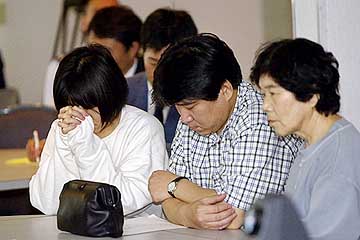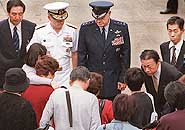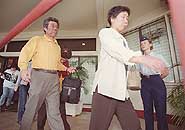 |
| Japanese families and officials listen to Coast Guard officials discuss the progress of the search for nine people who have been missing since a Navy submarine accidentally struck and sank a Japanese fishery training boat on Friday.
Associated Press |
 Missing students hoped to carry on tradition Missing students hoped to carry on tradition
 Retiring crewman among missing Retiring crewman among missing
 Probe to re-examine where subs should train Probe to re-examine where subs should train
 Coast Guard rescue timeline Coast Guard rescue timeline
 Previous stories Previous stories
By Dan Nakaso
and Mike Gordon
Advertiser Staff Writers
Federal investigators are examining the details of a fatal 1989 submarine accident that bears some resemblance to Friday’s collision between the USS Greeneville and a Japanese training vessel, the National Transportation Safety Board said yesterday.
 |
| NTSB officials John Hammerschmidt, left, and James Scheffer fielded questions during a press conference at the Waikiki Beach Marriott.
Eugene Tanner • The Honolulu Advertiser |
In both cases, the nuclear-powered, fast-attack submarines were using only their less-accurate "passive sonar" systems to check for surface traffic before their accidents.
The National Transportation Safety Board had urged the Navy in 1990 to require Navy subs to use their more sensitive "active sonar" systems before rising to periscope depth in U.S. coastal waters with a high volume of commercial traffic, NTSB member John Hammerschmidt said yesterday in Honolulu.
The NTSB recommendation came after the Houston, a Los Angeles-class submarine, snagged a tow cable attached to the tug Barcona, pulling it under and killing one of its sailors. The tug sank in 2,400 feet of water 10 miles southwest of Long Beach, Calif.
The USS Greeneville was using only its passive sonar in a submarine operation area 10 miles south of Diamond Head on Friday. The Greeneville’s crew was preparing to execute a "main emergency ballast blow" that would send the sub out of the ocean like a breaching whale.
"The submarine then made a sudden drop to a depth of 400 feet, at which point it began its emergency drill to return to the surface," Hammerschmidt said. "When it came close to the surface, the crew felt the submarine shudder."
Passive sonar amplifies sound in the water. Active sonar emits pings that bounce off objects and measure their range. But active sonar makes it easier for the submarine to be detected.
The collision left nine of the 35 people on board the Ehime Maru missing, include four teenagers, two instructors and three crewmen.
The Coast Guard and the Navy, and the Japanese training vessel Nippon Maru, a sailing ship operated by the Japanese government, were continuing the search last night and into this morning.
Hammerschmidt brought a copy of the 1990 report involving the Houston with him to Hawai‘i, but stressed there may not be any comparisons worth making with the Greeneville.
"I want to point out that we are not drawing any comparisons to the incident in 1989 and the one that occurred south of Honolulu," he said.
But the accident with the USS Houston represents the only other collision between a Navy submarine and a civilian vessel in U.S. waters that Hammerschmidt could recall.
NTSB investigators also will review the results of drug tests given to members of the Greeneville crew, Hammerschmidt said.
"We were informed they were requested by the U.S. Coast Guard of the appropriate personnel aboard the Greeneville," he said. "There were urine tests, for drugs, taken from navigation watch personnel."
Japanese Prime Minister Yoshiro Mori and the victims’ families want the United States to consider retrieving the Ehime Maru — which sank in 1,800 feet of water — because the missing fishermen might be in the wreckage. A Coast Guard spokesman said the request is being processed but the necessary equipment would need to be shipped to the Islands.
 |
| Family members of those missing from the Ehime Maru were met at the airport by Japanese and American officials, including, from left to right, Navy Rear Adm. Donald Kirkland, deputy chief of staff of the U.S. Pacific Fleet., Air Force Lt. Gen. Thomas Case, and, bowing, Japan Vice Minister of Foreign Affairs Yoshitaka Sakurada.
Deborah Booker • The Honolulu Advertiser |
NTSB investigators, who plan to inspect the Greeneville for the first time this afternoon, said they do not intend to ask the Navy to recover the Ehime Maru.
"It is not critical to this investigation," Hammerschmidt said. "We have a process that should allow us to understand this accident without looking at the wreckage. That’s just a preliminary thought at this point."
The Navy plans to inspect the Greeneville’s log books, any videotapes of periscope viewings and electronic records of acoustical readings.
The Coast Guard yesterday met with families of the victims at Sand Island. The private meeting was supposed to last one hour but stretched to an hour and 45 minutes as family members peppered officials with questions about the cause of the accident, the rescue response time and the scope of rescue efforts.
Coast Guard officials said they have covered 5,000 square miles of ocean off O‘ahu in three days and told worried families they will continue searching.
"We intend to search as long as we believe there is a reasonable hope that we will find survivors and that we will rescue them from this tragic incident," said Coast Guard operations chief Capt. Steven A. Williams.
Family members have asked to be taken to the scene of the collision, and the Coast Guard and Navy are considering the request, Williams said.
After the briefing, some family members ran to a chartered bus. Others walked with set faces and eyes averted. One woman, bent with grief, was held by others as they passed a phalanx of media.
Meanwhile, Navy officials in Honolulu defended the crew of the Greeneville, faced with increasing Japanese criticism that the Greeneville did not do enough after the collision.
Trying to conduct a rescue operation from a sub could have put the 26 fishermen in greater jeopardy, said Navy Lt. Cmdr. Dave Werner, spokesman for the U.S. Pacific Fleet’s Submarine Force.
 |
| Relatives of the missing walk to their bus following yesterday's briefing by Coast Guard officials on the recovery effort.
Eugene Tanner • The Honolulu Advertiser |
"No one wanted to offer more relief than this crew," Werner said. "The point is, what is in the best interests of the survivors?
"A submarine is designed to have a smooth hydrodynamic hull such that water easily flows over its rounded steel hull," Werner said. "While that is very effective in helping the submarine maneuver quietly underwater, it doesn’t lend itself to people standing on its curved surface, especially in higher seas."
Video footage taken of the Greeneville at the site of the collision shows that a rope ladder the crew deployed from the sub’s 20-foot-tall sail was slick with sea spray and swinging back and forth, Werner said. Climbing the sail would have been dangerous, he said, since the video shows waves washing over the deck and striking the sail.
Opening a hatch on the sub to retrieve the 26 survivors "presents a genuine safety risk ... in such sea states," Werner said. "You don’t want to open a 36-inch hole with nothing to stop it from coming in."
Deploying a rescue swimmer from the Greeneville would have been unnecessary because it appeared that all of the survivors were already in life rafts, Werner said.
Coast Guard spokesman Chief Petty Officer Gary Openshaw said the Greeneville did follow one life raft with only one survivor aboard while the other rafts had lashed themselves together.
In Nu‘uanu, members of the Honpa Hongwanji Mission held a moment of silence yesterday in memory of those still missing in Friday’s accident. Alan Goto said he was thinking about the parents who lost their children. Goto has two adult sons who are attending school on the Mainland.
"In our tradition, there’s some haiku poets that talk about the right order of things is grandparents die, parents die and children die. Here’s an incident in which we suffer because things have happened out of order," Goto said. "We can all universally empathize with them. As parents, we all fear that our children will go before us."
Melissa Mendonsa said she tried to have positive thoughts during the moment of silence.
"I thought about the young students, that hopefully their lives wouldn’t be in vain because this would bring awareness of how we can avoid something like this in the future," she said. "I was trying to get something positive out of this. Instead of bad feelings coming out of it, maybe more understanding can come between the nations."
Lane Hosoi-Shimonishi said he also was thinking about the relatives and friends of the nine missing crew members.
"My heart was going out to all of the families that may have lost a loved one," Hosoi-Shimonishi said.
Advertiser staff writers Walter Wright, Karen Blakeman and Curtis Lum, and translator Toshi Erikson, contributed to this report.
[back to top] |




